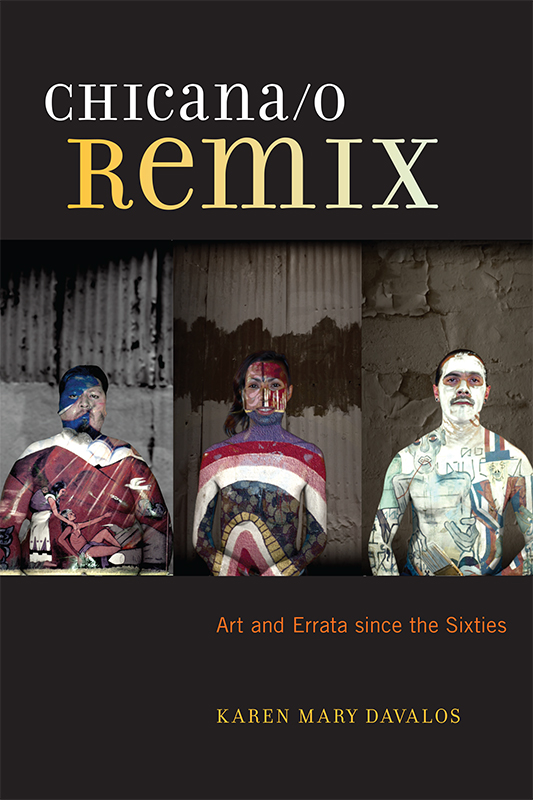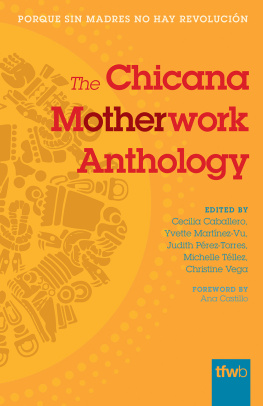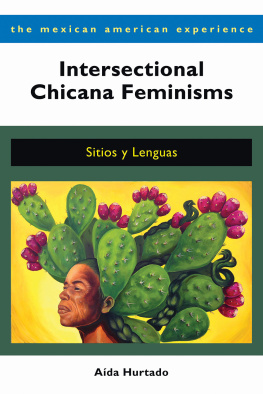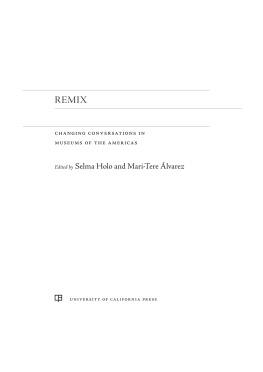
Chicana/o Remix
Chicana/o Remix
Art and Errata since the Sixties
Karen Mary Davalos

NEW YORK UNIVERSITY PRESS
New York
NEW YORK UNIVERSITY PRESS
New York
www.nyupress.org
2017 by New York University
All rights reserved
Book designed and typeset by Charles B. Hames
References to Internet websites (URLs) were accurate at the time of writing.
Neither the author nor New York University Press is responsible for URLs that
may have expired or changed since the manuscript was prepared.
Library of Congress Cataloging-in-Publication Data
Names: Davalos, Karen Mary, 1964 author.
Title: Chicana/o remix : art and errata since the sixties / Karen Mary Davalos.
Description: New York : New York University Press, 2017. | Includes bibliographical references and index.
Identifiers: LCCN 2016052434 | ISBN 9781479877966 (cl : alk. paper) |
ISBN 9781479821129 (pb : alk. paper)
Subjects: LCSH: Hispanic American art20th century. | Hispanic American art21st century. | ArtHistoriography.
Classification: LCC N6538.H58 D38 2017 | DDC 704.03/68dc23
LC record available at https://lccn.loc.gov/2016052434
New York University Press books are printed on acid-free paper,
and their binding materials are chosen for strength and durability.
We strive to use environmentally responsible suppliers and materials
to the greatest extent possible in publishing our books.
Manufactured in the United States of America
10 9 8 7 6 5 4 3 2 1
Also available as an ebook
Contents
1.1 Sandra de la Loza, in collaboration with Joseph Santarromana, Action Portraits (still from digital video), 2011
1.2 Sandra de la Loza, in collaboration with Joseph Santarromana, Action Portraits (still from digital video), 2011
2.1 Willie Herrn III, Sueos Hechos Realidad, 1972
2.2 Photograph from brochure for the exhibition Las Chicanas: Las Venas de la Mujer, 1976
2.3 Isabel M. Castro, Untitled (detail), 1976
2.4 Barbara Carrasco, Milk the Pass, 1990
2.5 Gilbert Magu Snchez Lujn, Trailing los Antepasados, 2000
2.6 Linda Arreola, Glyph #1, 2007
2.7 Linda Arreola, The Wall, 2008
3.1 David Botello, El Monumento de la Raza, 1970
3.2 David Botello, Tlalocn Commercial Center, 1972
3.3 David Botello, The Goez Map Guide to the Murals of East Los Angeles, 1975
3.4 Pages from the Community Arts Alliance directory, 1973
4.1 Ernesto de la Loza, Organic Stimulus, 1975
4.2 Francisco de Goya y Lucientes, The Third of May 1808 in Madrid, 1814
4.3 Linda Vallejo, Los Cielos, from the Los Cielos series, 1996
4.4 Linda Vallejo, Thunder, Lightning & Rain, 2006
4.5 Charles Chaz Bojrquez, Placa/Rollcall, 1980
4.6 Charles Chaz Bojrquez, Eddies Lament, 1994
4.7 Wayne Alaniz Healy and David Botello, Chicano Time Trip, 1977
4.8 David Botello, Dreams of Flight, 1973
4.9 David Botello, Read between the Lines, 1975
4.10 John Valadez, Battle of Culture, 1987
4.11 John Valadez, Europa #1, 1988
4.12 John Valadez, The Chase, 1989
4.13 Yolanda Gonzalez, Metamorphosis Nude Woman, 1994
4.14 Yolanda Gonzalez, Metamorphosis Nude with Red, 1994
5.1 Mariana Williamson Coronel in her parlor, 1896
6.1 Ricardo Valverde, Three Causes of Death, 1976
6.2 1970 campus newspaper review of 4 Chicano Artists
6.3 Los Four catalog, designed by Frank Romero, 1974
7.1 Graciela Iturbide, Cholos, Harpys, East L.A., 1986
7.2 Graciela Iturbide, Cholos, White Fence, East L.A., 1986
7.3 Sybil Venegas and Abel Mora Alejandre, Highland Park, Late 1970s: Web of Connections (detail), 2012
7.4 Map of Los Angeles arts institutions identified for Pacific Standard Time initiative
C hicana/o Remix: Art and Errata since the Sixties emerged from my considerable immersion in Chicana/o art. Starting in 2007 at the invitation of Chon A. Noriega, and following an established methodology in Chicana/o and feminist studies to reconstitute subjugated knowledge, I conducted seventeen life history interviews for the CSRC Oral Histories Series, a major project of the Chicano Studies Research Center (CSRC) at the University of California, Los Angeles (UCLA), with funding from the Getty Foundation and other sources. Oral history has emerged as the central method for investigating fifty years of Chicana/o art. In addition to the extensive oral history interviews with artists, I worked with them for dozens of additional hours correcting transcripts in an effort to publish the archive and get their story as accurate as possible. The life history interviews, which average ten hours per artist, left me with a strong impression that my view of Chicana/o art was likely incorrect, and from these sonic archival documents I began to envision the unmapped territory and new cartography that could accommodate the latest information.
Goldman, Ybarra-Frausto, Amalia Mesa-Bains, Terezita Romo, and Holly Barnet-Snchez, the paramount shapers of the field and authors of foundational scholarship in Chicana/o art history, consistently worked in curation, criticism, advocacy, and archival documentation.
Building the archive was a central project of Goldman, who invited Ybarra-Frausto to join her in the production of Arte Chicano: A Comprehensive Annotated Bibliography of Chicano Art (1985). Barnet-Snchez was present at the formation of Chicano Art: Resistance and Affirmation, 19651985, the major traveling exhibition and catalog that continues to serve as a reference. Goldman and her colleagues developed a coparticipatory methodology for investigating Chicana/o art that relied on immersion into the process and practice.
Following this coparticipatory approach, I undertook a research method that involved me in various roles and created a dense and broad understanding of Chicana/o art in Los Angeles. I volunteered as curator and advocate and I worked as part of a research team at UCLA that supported multiple exhibitions of Chicana/o art. However, my major use of coparticipatory research started in 2003, when I began attending weekly opening and closing receptions for art exhibitions; visiting with artists and sharing transportation, food, and leisure time with them; and attending public forums on Chicana/o art. I also gathered hundreds of ephemeral items and purchased rare and precious catalogs from exhibitions produced by arts organizations.
In addition to regular attendance at art exhibitions, I explored fifty years of Chicana/o art exhibitions through archival materials. Using this substantial record of expressive visual practice, I examine the errata exhibition, one of many patterns within the Chicana/o arts critical discourse (see chapter 2).
The coparticipatory methodology also took me to curation. During the research phase, I curated three exhibitions and wrote gallery or catalog essays for four local venues: Tropico de Nopal Gallery Art-Space, Avenue 50 Studio, Fremont Gallery, and the nationally recognized Self Help Graphics & Art. For these projects, I spoke at length with artists Linda Arreola, Margaret Garcia, CiCi Segura Gonzalez, Poli Marichal, Marianne Sadowski, and Linda Vallejo, as well as with artists, curators, and artistic directors Kathy Gallegos and Reyes Rodriguez. Curation brought me into a close circle of Chicana/o artists and advocates who were willing to provide me with insight and direction. It helped me consider the challenges of presence and the conditions under which Chicana/o art is made visible. It also made me more visible in the curatorial landscape of Los Angeles, and as a result of these projects I was invited to sit on panels as an expert on the local Chicana/o art scene, to recommend artists for exhibitions, and to identify scholars for catalog essays. Therefore, I was asked to describe and analyze the field as I was in the midst of investigating it, breaking the cardinal rules of Western social science researchits false separation between Self and Other and its mystified relationship between knowledge and power. Because coparticipatory research emerges from ethnic and feminist studies and from the social movements that gave rise to these interdisciplinary projects, it does not imagine a neutral research site or a detached observer. Indeed, it questions these assumptions as veils for social inequality, privilege, and knowledge production as an attempt to reproduce the status quo.
Next page





